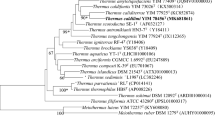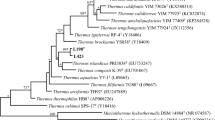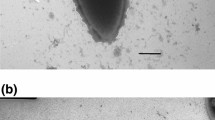Abstract
A thermophilic, strictly anaerobic bacterium, designated strain SL1, was isolated from a deep, continental oil reservoir in the East Paris Basin (France). This organism grew between 50 and 75°C, with an, optimum at 70°C. It was inhibited by elemental sulfur and was able to reduce cystine and thiosulfate to hydrogen sulfide. The G+C content (40 mol%), the presence of a lipid structure unique to the genusThermotoga, and the 16S rRNA sequence of strain SL1 indicated that the isolate belongs to the genusThermotoga. Based on DNA-DNA hybridization, isolate SL1 does not show species-level similarity with the recognized speciesT. maritima, T. neapolitana, andT. thermarum. Based on this description of strain SL1, we propose the recognition of a new species:Thermotoga subterranea.
Similar content being viewed by others
References
Achenbach-Richter L, Gupta R, Stetter KO, Woese CR (1987) Were the original eubacteria thermophiles? Syst Appl Microbiol 9:34–39
Balch WE, Wolfe RS (1976) New approach to the cultivation of methanogenic bacteria: 2-mercaptoethanesulfonic acid (HS-CoM)-dependent growth ofMethanobacterium ruminantium in a pressurized atmosphere. Appl Environ Microbiol 32:781–791
Balch W, Fox GE, Magrum LS, Woese CR, Wolfe RS (1979) Methanogens: reevaluation of a unique biological group. Microbiol Rev 43:260–296
Beeder J, Nilsen RK, Rosnes JT, Torsvik T, Lien T (1994)Archaeoglobus fulgidus isolated from hot North Sea oil field waters. Appl Environ Microbiol 60:1227–1231
Bernard FP, Connan J, Magot M (1992) Indigenous microorganisms in connate water of many oil fields: a new tool in exploration and production techniques. In: Proceedings of the 67th annual technical conference and exhibition of the Society of Petroleum Engineers. pp 467–476
Blumentals II, Itoh M, Olson GJ, Kelly RM (1990) Role of polysulfides in reduction of elemental sulfur by the hyperthermophilic archaebacteriumPyrococcus furiosus. Appl Environ Microbiol 56:1255–1262
Burggraf S, Olsen GJ, Stetter KO, Woese CR (1992) A phylogenetic analysis ofAquifex pyrophilus. Syst Appl Microbiol 15: 352–356
Charbonnier F, Forterre P (1994) Comparison of plasmid DNA topology among mesophilic and thermophilic eubacteria and archaebacteria. J Bacteriol 176:1251–1259
Christensen B, Torsvik T, Lien T (1992) Immunomagnetically captured thermophilic sulfate-reducing bacteria from North Sea oil field waters. Appl Environ Microbiol 58:1244–1248
Cline JD (1969) Spectrophotometric determination of hydrogen sulfide in natural waters. Limnol Oceanogr 14:454–458
Davey ME, Wood WA, Key R, Nakamura K, Stahl DA (1993) Isolation of three species ofGeotoga andPetrotoga: two new genera, representing a new lineage in the bacterial line of descent distantly related to the “Thermotogales”. Syst Appl Microbiol 16:191–200
De Rosa M, Gambacorta A, Huber R, Lanzotti V, Nicolaus B, Stetter KO, Trincone A (1989) Lipid structures inThermotoga maritima. In: Da Costa MS, Duarte JC, Williams RAD (eds) Microbiology of extreme environments and its potential for biotechnology. Elsevier, Amsterdam New York, pp 167–173
De Soete G (1983) A least squares algorithm for fitting additive trees to proximity data. Psychometrika 48:621–626
Erauso G, Reysenbach AL, Godfroy A, Meunier JR, Crump B, Partensky F, Barros JA, Marteinsson VT, Barbier G, Pace NR, Prieur D (1993)Pyrococcus abyssi sp. nov., a new hyperthermophilic archaeon isolated from a deep-sea hydrothermal vent. Arch Microbiol 160:338–349
Felsenstein J (1981) Evolutionary trees from DNA sequences: a maximum-likelihood approach. J Mol Evol 17:368–376
Felsenstein J (1985) Confidence limits on phylogenies: an approach using the bootstrap. Evolution 39:783–791
Ghiorse WC, Wilson JT (1988) Microbial ecology of the terrestrial subsurface. Adv, Appl Microbiol 33:107–172
Grassia G, McLean KM, Glénat P, Sheehy AJ (1991) Thermophilic bacteria from petroleum reservoirs (abstract). Proceedings of the Australian Society for Microbiology Annual Scientific Meeting S21.3
Huber R, Stetter KO (1992) The order Thermotogales. In: Balows A, Trüper HG, Dworkin M, Harder W, Schleifer KH (eds) The prokaryotes, 2nd edn. Springer, Berlin Heidelberg New York, pp 3809–3815
Huber R, Langworthy TA, König H, Thomm M, Woese CR, Sleytr UB, Stetter KO (1986)Thermotoga maritima sp. nov. represents a new genus of unique extremely thermophilic eubacteria growing up to 90°C. Arch Microbiol 144:324–333
Huber R, Woese CR, Langworthy TA, Fricke H, Stetter KO (1989)Thermosipho africanus gen. nov. represents a new genus of thermophilic eubacteria within the “Thermotogales”. Syst Appl Microbiol 12:32–37
Huber R, Woese CR, Langworthy TA, Kristjansson JK, Stetter KO (1990)Fervidobacterium islandicum sp. nov., a new extremely thermophilic eubacterium belonging to the “Thermotogales”. Arch Microbiol 154:105–111
Ingvorsen K, Jorgensen BB (1979) Combined measurement of oxygen and sulfide in water samples. Limnol Oceanogr. 24: 390–393
Ivanova TL, Turova TP, Antonov AS (1988) DNA-DNA hybridization studies on some purple non-sulfur bacteria. Syst Appl Microbiol 10:259–263
Jannasch HW, Huber R, Belkin S, Stetter KO (1988)Thermotoga neapolitana sp. nov. of the extremely thermophilic, eubacterial genusThermotoga. Arch Microbiol 150:103–104
Johnson JL (1985) DNA reassociation and RNA hybridisation of bacterial nucleic acids. In: Krieg NR, Holt JG (eds) Bergey's manual of systematic bacteriology, vol 1. Williams & Wilkins, Baltimore, pp 8–12
Kristjánsson JK, Hjörleifsdóttir S, Marteinsson VT, Alfredsson GA (1994)Thermus scotoductus sp. nov., a pigment-producting thermophilic bacterium from hot tap water in Iceland and includingThermus sp. X-1. Syst Appl Microbiol 17:44–50
Lowe SE, Jain MK, Zeikus JG (1993) Biology, ecology, and biotechnological applications of anaerobic bacteria adapted to environmental stresses in temperature, pH, salinity, or substrates. Microbiol Rev 57:451–509
Maidak BL, Larsen NG, McCaughey MJ, Overbeek R, Olsen GJ, Fogel K, Blandy J, Woese CR (1994) The ribosomal, database project. Nucleic Acids Res 22:3485–3487
Marmur J, Doty D (1962) determination of the base composition of deoxyribonucleic acid from its thermal denaturation temperature. J Mol Biol 5:109–118
Patel BKC, Morgan HW, Daniel RM (1985)Fervidobacterium nodosum gen. nov. and sp. nov., a new chemoorganotrophic caldoactive, anaerobic bacterium. Arch Microbiol 141:63–69
Reysenbach AL, Giver LJ, Wickham GS, Pace NR (1992) Differential amplification of rRNA genes by polymerase chain reaction. Appl Environ Microbiol 58:3417–3418
Rosnes JT, Torsvik T, Lien T (1991) Spore-forming thermophilic sulfate-reducing bacteria isolated from North Sea oil field waters. Appl Environ Microbiol 57:2302–2307
Rozanova EP, Nazina TN (1979) Occurrence of thermophilic sulfate-reducing bacteria in oil-bearing strata of Apsheron and Western Siberia. Microbiology (English translation of Mikrobiologiia) 48:907–911
Saiki RK, Gelfand DH, Stoffel SJ, Scharf S, Higuchi R, Horn GT, Mullis HB, Erlich HA (1988) Primer-directed enzymatic amplification of DNA with a thermostable DNA polymerase. Science 230:1350–1354
Sambrook J, Fritch EF, Maniatis T (1989) Molecular cloning: a laboratory manual, 2nd edn. Cold Spring Harbor Laboratory Press, Cold Spring Harbor
Sanger F, Nicklen S, Coulson AR (1977) DNA sequencing with chain-terminating inhibitors. Proc Natl Acad Sci USA 74:5463–5483
Sorbö B (1957) A colorimetric method for the determination of thiosulfate. Biochim Biophys Acta 23:412–416
Stetter KO, Huber R, Blochl E, Kurr M, Eden RD, Fielder M, Cash H, Vance I (1993) Hyperthermophilic archaea are thriving in deep North Sea and Alaskan oil reservoirs. Nature 365:743–745.
Windberger E, Huber R, Trincone A, Fricke H, Stetter KO (1989)Thermotoga thermarum sp. nov. andThermotoga neapolitana occurring in African continental solfataric springs. Arch Microbiol 151:506–512
Author information
Authors and Affiliations
Corresponding author
Rights and permissions
About this article
Cite this article
Jeanthon, C., Reysenbach, AL., L'Haridon, S. et al. Thermotoga subterranea sp. nov., a new thermophilic bacterium isolated from a continental oil reservoir. Arch. Microbiol. 164, 91–97 (1995). https://doi.org/10.1007/BF02525313
Received:
Accepted:
Issue Date:
DOI: https://doi.org/10.1007/BF02525313




